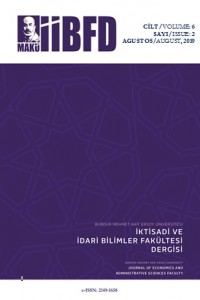BULGARİSTAN’DA TÜRK AZINLIĞA UYGULANAN ŞİDDET (1944-1989): GALTUNG’UN BARIŞ MODELİ BAĞLAMINDA BİR İNCELEME
Abstract
Profesör Johan Galtung’un şiddet ve barış
anlayışı Uluslararası İlişkiler disiplininde barış ve çatışma gibi temel problemlerin
daha kolay anlaşılıp özellikle de çatışma çözümleri bağlamında kalıcı
çözümlerin oluşturulmasında önemli rol oynamaktadır. Bu makale, Bulgaristan
Komünist Partisi’nin (BKP) iktidarı döneminde (1944-1989) Bulgaristan’da
yaşayan Türk azınlığının durumunu Galtung’un geliştirdiği şiddet ve barış
kavramlarının perspektifinden analiz etmektedir. Resmi arşiv belgeleri ve bu
belgeliklerden üretilmiş ikincil kaynaklar ışığında ilgili dönemdeki
(1944-1989) Türk azınlığının sosyoekonomik ve kültürel durumu analiz edilerek
şiddet durumları tespit edilmeye çalışılmıştır. Bu dönemde Türklerin maruz
kaldıkları şiddet/çatışma durumlarının iyi anlaşılması Soğuk Savaş sonrası
tesis edilen göreceli pozitif barış hâlinin hak ettiği değeri görmesi açısından
son derece önemli olmaktadır.
References
- DREZOV, K. (2001), Bulgaria and Macedonia: Voluntary Dependence on External Actors, J. ZIELONKA ve A. PRAVDA içinde Democratic Consolidation in Eastern Europe: International and Transitional Factors, (p. 413-436), New York: Oxford University Press.
- GALTUNG, J. (1969), Violence, Peace and Peace Research, Journal of Peace Research, (6)3, 167-191.
- GALTUNG, J. (1990), Cultural Violence, Journal of Peace Research, (27)3, 291-305.
- KOLEVA, D. (2012), Belene: Remembering the Labour Camp and the History of Memory, Social History, (37)1, 1-18.
- WEBEL, C. (ed.) ve GALTUNG, J. (ed.) (2007). Handbook of Peace and Conflict Studies. New York: Routledge.
THE VIOLENCE APPLIED TO THE TURKISH MINORITY IN BULGARIA (1944-1989): AN INVESTIGATION IN THE CONTEXT OF THE GALTUNG'S PEACE MODEL
Abstract
Professor Johan Galtung's understanding of
violence and peace plays an important role for understanding the basic problems
such as peace and conflict in the International Relations discipline, and in
particular, it is important for establishment of permanent solutions in the
context of conflict resolution. This article analyses the situation of the
Turkish minority living in Bulgaria during the rule of the Bulgarian Communist
Party (BCP) (1944-1989), in particular from the perspective of violence and
peace concepts developed by Galtung. In order to identify the violence
situations, it was analysed the socio-economic and cultural situation of the
Turkish minority in the relevant period (1944-1989), in the light of official
archival documents and secondary sources reproduced by this archives. A good
understanding of the violence/conflict situations, which are experienced by the
Turks during this period, is extremely important in terms of seeing the value
of relative positive peace, established in the post-Cold War period.
References
- DREZOV, K. (2001), Bulgaria and Macedonia: Voluntary Dependence on External Actors, J. ZIELONKA ve A. PRAVDA içinde Democratic Consolidation in Eastern Europe: International and Transitional Factors, (p. 413-436), New York: Oxford University Press.
- GALTUNG, J. (1969), Violence, Peace and Peace Research, Journal of Peace Research, (6)3, 167-191.
- GALTUNG, J. (1990), Cultural Violence, Journal of Peace Research, (27)3, 291-305.
- KOLEVA, D. (2012), Belene: Remembering the Labour Camp and the History of Memory, Social History, (37)1, 1-18.
- WEBEL, C. (ed.) ve GALTUNG, J. (ed.) (2007). Handbook of Peace and Conflict Studies. New York: Routledge.
Details
| Primary Language | Turkish |
|---|---|
| Journal Section | Research Articles |
| Authors | |
| Publication Date | August 29, 2019 |
| Submission Date | March 1, 2019 |
| Published in Issue | Year 2019 Volume: 6 Issue: 2 |

This work is licensed under a Creative Commons Attribution 4.0 International License.
The author(s) bear full responsibility for the ideas and arguments presented in their articles. All scientific and legal accountability concerning the language, style, adherence to scientific ethics, and content of the published work rests solely with the author(s). Neither the journal nor the institution(s) affiliated with the author(s) assume any liability in this regard.


